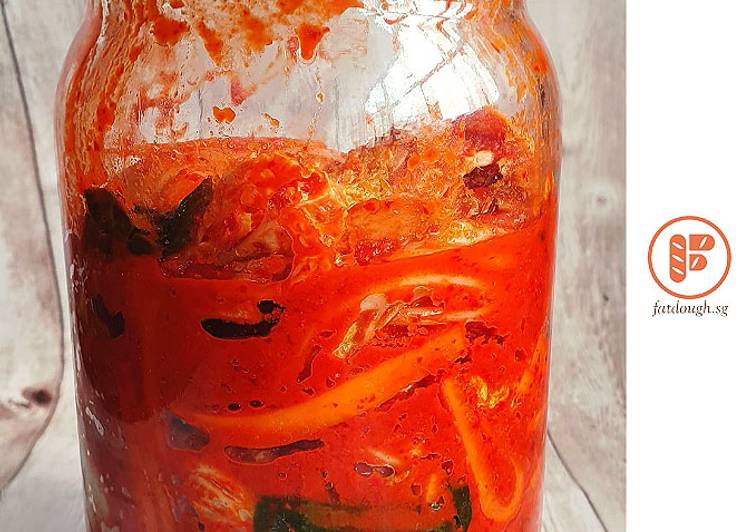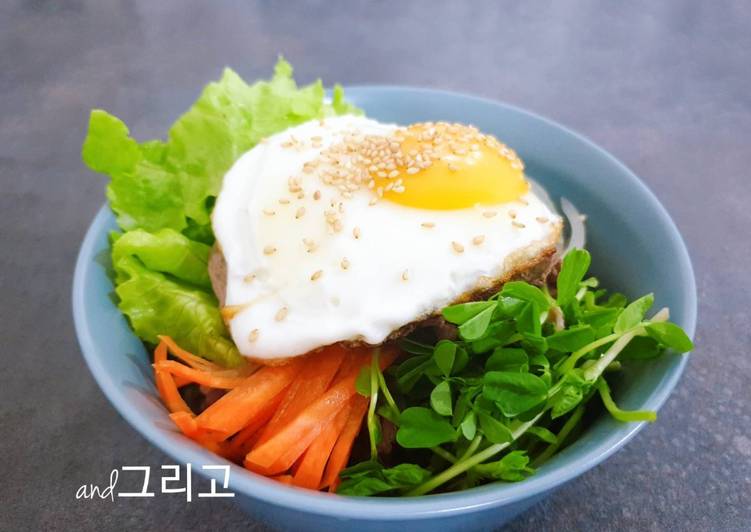
Hey everyone, it’s Brad, welcome to my recipe site. Today, I’m gonna show you how to make a distinctive dish, korean kimchi. One of my favorites food recipes. This time, I’m gonna make it a bit tasty. This is gonna smell and look delicious.
Korean Kimchi is one of the most well liked of recent trending meals on earth. It is simple, it’s quick, it tastes delicious. It’s enjoyed by millions daily. Korean Kimchi is something which I’ve loved my whole life. They’re nice and they look fantastic.
Place the kimchi in the fridge until it's fermented to your liking. Kimchi (김치) is a collective term for vegetable dishes that have been salted, seasoned, and fermented. The history of kimchi goes back to ancient times.
To get started with this recipe, we must first prepare a few components. You can have korean kimchi using 14 ingredients and 7 steps. Here is how you cook it.
The ingredients needed to make Korean Kimchi:
- Get 2 pieces Chinese Cabbage
- Get 1/2 cup Rock Salt
- Take 1/2 cup Glutinous Rice Flour
- Take 1/4 cup White Sugar
- Make ready 3 cups Water
- Get 1 cup Garlic
- Make ready 2 tablespoons Ginger
- Make ready 1 cup White Onion
- Get 1 cup Fish Sauce
- Prepare 2 cups Gochugaru
- Get 4 stalks Leeks
- Make ready 1 piece Carrot
- Get 1 piece Radish
- Take Honey (optional)
Koreans eat it at nearly every meal. It can be fresh, like a salad, or it can be fermented. While the most popular variety is spicy kimchi made of cabbage, there are hundreds of different types of kimchi made of different vegetables, and not all of them spicy. Kimchi is a classic Korean pickle that can be made from just about any vegetable.
Instructions to make Korean Kimchi:
- PREPARE THE CABBAGE - - Cut the cabbage lengthwise into quarters, then chop into bite-size pieces. Soak in cold water for 5 minutes. Drain and transfer to a large bowl.
- Add 1/2 cup salt and mix well; turn it over after 30 minutes. - repeat 2x (total of 1 hour) - - Rinse and drain for 3x. Squeeze out water on the last time, put on a strainer and let it air dry for 30 minutes.
- MAKE THE GLUTINOUS PASTE - - Dilute the rice flour in water. Heat and bring to boil while stirring, for about 5 minutes. Lower the heat. - - When you see it bubbling, add sugar. Cook for a few more minutes until it becomes translucent. Let it cool completely. - - Tip: To cool faster, but the pot in a pan half-filled with water; just make sure that the pot is taller than the pan.
- PREPARE THE KIMCHI SAUCE - - Using the food processor, chop and blend the garlic, ginger, onion, and fish sauce for about 1 minute. Mix it with the cooled glutinous paste and hot pepper flakes.
- Wash the leeks thoroughly. Dry it with paper towel and cut diagonally. Peel the carrot and radish and cut into thin strips. Add the leeks, carrots, radish, (and honey) to the kimchi sauce and mix well. - - You can taste test and adjust depending on the level of heat, saltiness, and sweetness that you prefer.
- MIX THE KIMCHI - - In a clean large bowl, put the cabbage and add the sauce gradually. Use clean and dry hands (or use a clean food-grade gloves) to mix the ingredients. Make sure to distribute the kimchi sauce evenly and all cabbage pieces have been covered with sauce. Transfer to a clean container and press it to remove air bubbles. Leave at room temperature and place in a dark area or cover it with dry clean towel. Transfer to the ref on the 3rd day.
- Best eaten after its 1st to 2nd week of fermentation.
This one uses wombok (Chinese cabbage) and is pungent and addictive. Kimchi (김치) consists of cabbage that has been salted and fermented, over a number of days, in a spicy sauce made up from a large number of ingredients including chilli powder, spring onions, fish sauce and onion. "Kimchi is the national food of Korea and comes in many forms but this one is the most widely known and eaten. Kimchi Jjigae (김치찌개) also known as Kimchi stew or Kimchi soup is probably the most common way of consuming some aged Kimchi. It is a such a staple food in Korean households that typically Koreans would eat it at least once or twice a week if Kimchi / Kimchee (김치) is Korean fermented cabbage and it's an integral ingredient in Korean cuisine. Many Koreans eat kimchi every day if not at every meal!
So that’s going to wrap it up for this special food korean kimchi recipe. Thank you very much for reading. I am sure that you will make this at home. There is gonna be interesting food in home recipes coming up. Don’t forget to save this page on your browser, and share it to your family, colleague and friends. Thanks again for reading. Go on get cooking!


